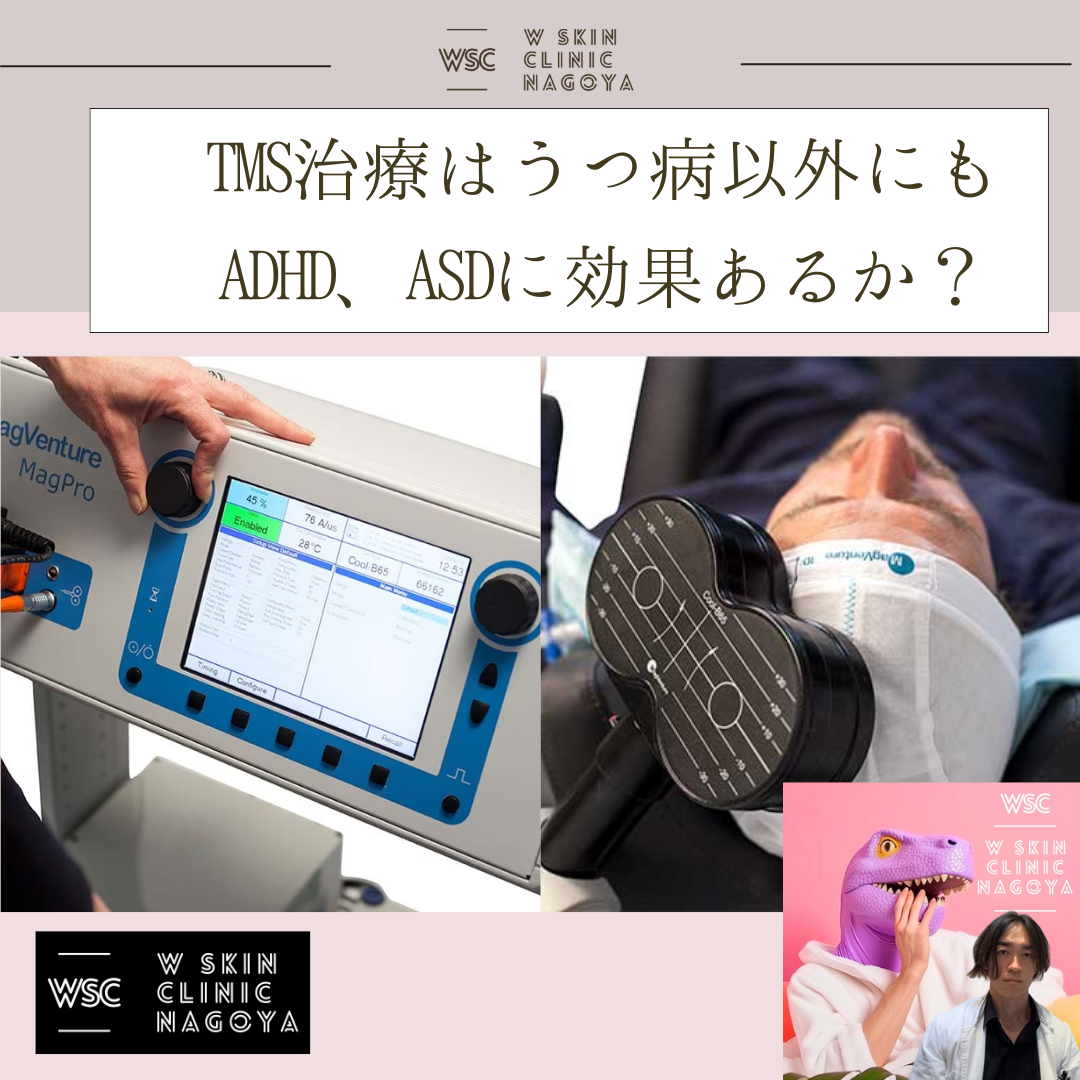NEWSお知らせ
2024.11.19|ブログ
TMS治療はADHDやASDに対してもなんらかの有効性を発揮するか?その根拠は?名古屋の美容皮膚科医が解説

TMS治療はADHDやASDに対してもなんらかの有効性を発揮するか?その根拠は?名古屋の美容皮膚科医が解説
こんにちは、Wスキンクリニック名古屋、院長の加藤晃司です。
今回は、TMS治療はADHDやASDに対してもなんらかの有効性を発揮するか?その根拠は?について解説します。
TMS(経頭蓋磁気刺激)治療は、うつ病や不安障害の治療として広く用いられていますが、近年ではADHD(注意欠如・多動症)やASD(自閉スペクトラム症)に対しても有効性がある可能性が示されています。以下に、TMSがADHDやASDに効果を発揮する根拠と、作用メカニズムについて詳細に解説します。
- TMS治療の概要
TMS治療は、頭皮の上から脳に磁気パルスを送ることで脳内の神経活動を刺激または抑制する治療法です。TMSは特に前頭前野や運動皮質といった、認知機能や行動制御に関与する脳領域に働きかけます。脳の神経回路に影響を与え、特定の症状に対して改善効果をもたらすと考えられています。
- TMSがADHDに有効とされる理由とメカニズム
ADHDは、注意欠如や衝動性、過活動を特徴とする神経発達障害であり、前頭前野の活動低下が一因とされています。TMSがこの症状に有効とされる根拠には、以下の点が挙げられます。
- 前頭前野の機能向上
TMSは、特に前頭前野(前頭皮質)の機能向上に役立つことが確認されています。ADHD患者は、前頭前野が十分に機能していないために衝動性や注意力の低下が見られます。TMSによって前頭前野を刺激することで、認知機能や注意の持続力、抑制機能が改善されるとされています。
- 神経伝達物質のバランス調整
ADHDにはドーパミンやノルアドレナリンといった神経伝達物質の不均衡が関与しています。TMSはこれらの神経伝達物質の分泌を促進または調整する作用があるため、ADHDの症状改善に有効と考えられます。例えば、TMSによってドーパミンの分泌が調整されることで、注意力や集中力の向上が期待されます。
- 前頭皮質のネットワーク強化
ADHDは、前頭皮質と後頭皮質をつなぐ神経回路のネットワーク機能が不十分なことが原因とされています。TMSはこの神経回路に直接的に作用し、神経ネットワークの強化を促します。このネットワーク強化により、注意力や抑制能力が高まり、ADHDの症状が改善される可能性があります。
- 研究結果
一部の研究では、TMS治療によってADHD患者の注意力、集中力、衝動性が改善されたとの報告があります。特に、低頻度のTMSが前頭前野を刺激した場合に、行動や認知機能の向上が確認されたことが、ADHD治療に対するTMSの有効性を示す根拠となっています。
- TMSがASD(自閉スペクトラム症)に有効とされる理由とメカニズム
ASDは、社会的なコミュニケーションや行動に特徴的な症状を持つ神経発達障害です。TMSがASDに効果を発揮する可能性があるとされる背景には、以下のような理由があります。
- 社会的認知を司る脳領域への刺激
ASDの症状には、前頭前野や側頭葉などの神経ネットワークの機能不全が関わっていると考えられています。TMSでこれらの脳領域を刺激することで、社会的認知やコミュニケーションに必要な神経回路が活性化されるため、対人関係や社会的なやり取りが改善されると考えられています。
- 神経過敏症状の軽減
ASDでは、音や光、触覚などの感覚に対する過敏性が見られることがあります。TMSが神経伝達物質のバランスを整えることで、感覚の過敏症状が軽減されることが確認されており、生活の質向上に寄与する可能性があります。
- 神経可塑性の促進
TMSは、脳の可塑性を高める作用があるため、ASD患者の神経ネットワークが適切に再編され、行動やコミュニケーションの柔軟性が増すと考えられています。ASDにおいては、脳の特定の領域が過度に活性化している場合があるため、TMSがその過活動を抑制することも期待されます。
- 実際の研究報告
ASD患者に対するTMSの研究では、言語発達や対人コミュニケーションスキルが向上したケースが報告されています。特に、前頭前野や側頭頭頂接合部にTMSを適用することで、社会的認知やコミュニケーション能力の改善が見られることが分かっています。
- ADHDやASDに対するTMS治療の実際的な効果と課題
- 治療効果の持続性
ADHDやASDに対するTMSの効果は、個人差があるため一時的な改善にとどまる場合もあります。治療効果を持続させるには、定期的な治療が必要となることがあります。
- 標準治療法としての確立には至っていない
ADHDやASDへのTMS治療は、依然として試験的な段階にあり、標準的な治療法としては確立されていません。多くの研究が進められていますが、まだ明確な効果や安全性が確認されていない部分もあります。
まとめ
TMS治療は、ADHDやASDに対しても一定の効果を発揮する可能性があり、次のようなメカニズムによって症状改善が期待されています。
前頭前野や神経ネットワークの活性化:ADHDやASDで問題となる脳領域に働きかけ、認知機能や社会的認知を高める。
神経伝達物質の調整:ドーパミンやノルアドレナリンの分泌を調整し、衝動性や集中力、感覚過敏を改善。
神経可塑性の促進:脳の可塑性を高め、神経回路が適切に再編されることで、行動やコミュニケーションの柔軟性が増す。
課題:効果の持続性に個人差があること、標準治療としての確立には至っていないことが挙げられる。
ADHDやASDにおいてTMSが効果を発揮する可能性はあるものの、さらなる研究が必要であり、適用する際には専門医との相談が重要です。
TMS治療はこちら
https://www.w-clinic-nagoya.com/tms
Wスキンクリニック名古屋でのエクソソーム治療はこちら
https://www.w-clinic-nagoya.com/acne/exosome
NMN点滴はこちら
https://www.w-clinic-nagoya.com/beauty-drip/nmn
高濃度ビタミンC点滴はこちら
https://www.w-clinic-nagoya.com/beauty-drip/vitamin-c
*当院では
NMNは一般社団法人NMN医療研究会、エクソソームはセルソース株式会社のM2P-エクソソームを使用しています。
当院では無料でスタッフカウンセリングを行なっております。
お気軽にご予約くださいませ
Wスキンクリニック名古屋 (美容皮膚科)
https://www.w-clinic-nagoya.com/
〒461-0005 愛知県名古屋市東区東桜 2-4-1 第3コジマビル6F
TEL 052-7377-7117(10:00~19:00)
LINE ID @w.nagoya
高岳駅より徒歩4分 / 新栄町駅より徒歩5分
お車でお越しの方
名鉄協商パーキングチケットをお渡しいたしますので、クリニック近くのパーキングをご利用ください。
ご予約、お問合せ、Wスキンクリニック名古屋公式LINEからも可能です。
LINE ID : @w.nagoya
友達追加は↓から
Wスキンクリニック名古屋公式インスタ↓
https://www.instagram.com/w.skinclinic.nagoya?igsh=NHhoODFnaXB2b2ll&utm_source=qr
Wスキンクリニック院長 加藤晃司インスタ↓
https://www.instagram.com/w.skin.nagoya.kojikato?igsh=aW9nbWZwNjNjZ3pz&utm_source=qr
Can TMS Therapy Be Effective for ADHD and ASD? An Explanation by a Cosmetic Dermatologist in Nagoya
Hello, I’m Dr. Koji Kato, Director of W Skin Clinic Nagoya.
Today, I’ll discuss whether TMS (Transcranial Magnetic Stimulation) therapy can be effective for ADHD (Attention Deficit Hyperactivity Disorder) and ASD (Autism Spectrum Disorder), along with the underlying mechanisms that support its potential.
What Is TMS Therapy?
TMS therapy involves delivering magnetic pulses to specific areas of the brain through the scalp. This non-invasive procedure can stimulate or inhibit neural activity in targeted regions, making it effective for various mental health conditions, primarily depression and anxiety. Emerging research indicates its potential benefits for neurodevelopmental disorders like ADHD and ASD, where specific brain dysfunctions play a critical role.
TMS for ADHD: Mechanisms and Evidence
ADHD is characterized by inattention, impulsivity, and hyperactivity, often linked to reduced activity in the prefrontal cortex.
- Enhancing Prefrontal Cortex Function
Targeting the Prefrontal Cortex: TMS stimulates the dorsolateral prefrontal cortex (DLPFC), an area critical for executive functions like attention and impulse control.
Effect: Improved focus, reduced impulsivity, and better self-regulation.
- Balancing Neurotransmitters
Impact on Dopamine and Norepinephrine: ADHD involves imbalances in these neurotransmitters. TMS influences their release and regulation, potentially improving symptoms like poor attention and hyperactivity.
Effect: Enhanced concentration and reduced distractibility.
- Strengthening Neural Networks
Improved Connectivity: ADHD is associated with weak connections between the prefrontal cortex and other brain areas. TMS enhances these networks, improving overall cognitive control.
Effect: Better coordination of attention and inhibitory control.
- Clinical Evidence
Studies show that low-frequency TMS targeting the prefrontal cortex can improve ADHD symptoms, particularly attention and impulse control.
Some patients report sustained benefits after several sessions, although individual responses vary.
TMS for ASD: Mechanisms and Evidence
ASD involves deficits in social communication, restricted interests, and sensory sensitivities. Dysfunction in specific brain areas like the prefrontal cortex and temporal lobes contributes to these challenges.
- Stimulating Social Cognition Regions
Key Areas: TMS targets the prefrontal cortex and temporoparietal junction (TPJ), regions responsible for social cognition and communication.
Effect: Improved social interaction and reduced difficulty in understanding others’ emotions.
- Reducing Sensory Overload
Sensory Regulation: ASD often includes heightened sensitivity to sensory stimuli. TMS helps normalize neural activity, reducing hypersensitivity to light, sound, and touch.
Effect: Improved tolerance to sensory input, enhancing daily functioning.
- Promoting Neuroplasticity
Rewiring the Brain: TMS promotes neuroplasticity, allowing the brain to adapt and reorganize itself. This can improve flexibility in thought patterns and behaviors.
Effect: Enhanced communication skills and reduced rigidity.
- Clinical Evidence
Research indicates improvements in language development and social interaction after TMS sessions.
Patients also report reduced repetitive behaviors and better adaptability in social situations.
Challenges and Limitations
- Individual Variability
Response to TMS varies widely among individuals with ADHD or ASD. Factors like age, symptom severity, and brain anatomy influence outcomes.
- Temporary Effects
While some patients experience lasting benefits, others may need ongoing maintenance sessions for sustained improvement.
- Limited Standardization
TMS is not yet an established standard treatment for ADHD or ASD. More research is needed to determine optimal protocols and long-term efficacy.
TMS for ADHD and ASD: Practical Insights
Who May Benefit?
ADHD patients who struggle with medication side effects or require complementary therapy.
ASD individuals facing severe social or sensory challenges.
Treatment Protocol
ADHD: Low-frequency TMS targeting the prefrontal cortex, typically in weekly sessions over several weeks.
ASD: Tailored stimulation of the prefrontal cortex or TPJ, depending on specific symptoms.
Safety and Tolerability
TMS is generally safe, with mild side effects like headache or scalp discomfort. It is non-invasive and requires no downtime.
Summary
TMS therapy shows promise for managing symptoms of ADHD and ASD, with the following potential benefits:
For ADHD: Enhanced attention, reduced impulsivity, and improved focus through prefrontal cortex stimulation.
For ASD: Better social communication, reduced sensory sensitivities, and increased cognitive flexibility.
While current evidence supports its effectiveness, TMS for ADHD and ASD remains experimental, and more research is needed to establish it as a standard treatment. Collaborating with a qualified specialist ensures the therapy is appropriately tailored to individual needs.
If you or someone you know is exploring treatment options for ADHD or ASD, TMS may provide a valuable addition to traditional therapies.




